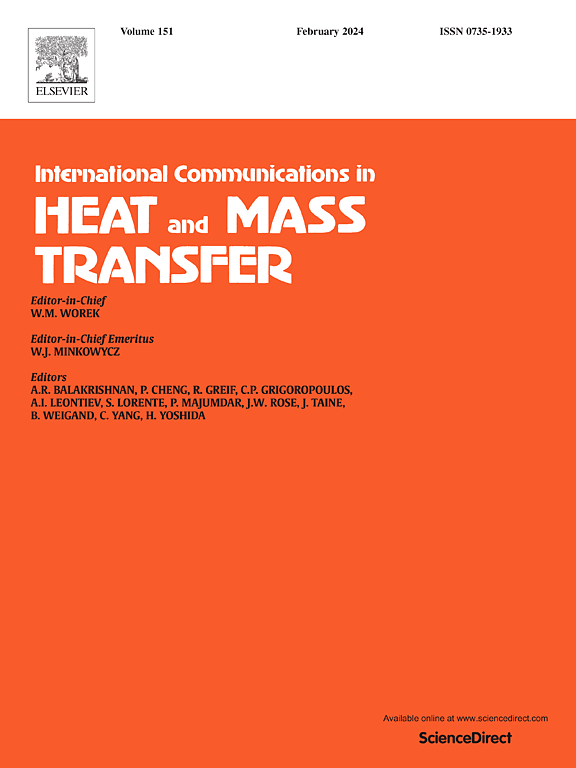部分填充金属泡沫的夹层传热装置性能增强设计
IF 6.4
2区 工程技术
Q1 MECHANICS
International Communications in Heat and Mass Transfer
Pub Date : 2025-05-13
DOI:10.1016/j.icheatmasstransfer.2025.109086
引用次数: 0
摘要
本文提出了一种新型的波纹金属泡沫夹层换热装置,并对其进行了数值研究,引入了一种独特的结构设计来提高热工性能。基于Forchheimer-Brinkman扩展Darcy模型和局部热非平衡方法,建立了三维固流耦合模型,验证了新设计的有效性。与一般的板泡沫结构相比,波浪形结构显著提高了传热能力,层流和湍流条件下的努塞尔数分别提高了118.3% - 89.7%和74.7% - 173.3%。这种增强主要归因于双高速区域的形成,这加强了场的协同作用,促进了高效的传热。此外,可穿透的波浪界面有效地消除了再循环细胞,导致压降适度且可接受的增加。进行了全面的参数研究,考察了通道宽度,翅片高度,振幅,波长,孔隙率和孔隙密度的影响。这些研究结果表明,与传统的金属泡沫热交换器相比,波浪夹层传热装置是一种有前途的、从根本上不同的替代方案,它在可接受的压降损失下提供了优化的热性能。本文章由计算机程序翻译,如有差异,请以英文原文为准。
A novel design for performance enhancement in sandwich heat transfer unit with partially filled metal foam
A novel wavy metal foam sandwich heat transfer unit is proposed and numerically investigated in this study, introducing a unique structural design to enhance thermal-hydraulic performance. A three-dimensional solid-fluid coupling model, based on the Forchheimer-Brinkman extended Darcy model and the local thermal non-equilibrium method, is established to validate the effectiveness of the new design. Compared to general plate metal foam structures, the wavy configuration significantly improves heat transfer capability, achieving a 118.3 %–89.7 % and 74.7 %–173.3 % increase in the Nusselt number under laminar and turbulent conditions, respectively. The enhancement is primarily attributed to the formation of dual high-velocity regions, which strengthen field synergy and promote efficient heat transfer. Moreover, the penetrable wavy interface effectively eliminates recirculation cells, leading to a moderate and acceptable increase in pressure drop. A comprehensive parametric study is conducted, examining the effects of channel width, fin height, amplitude, wavelength, porosity, and pore density. These findings establish the wavy sandwich heat transfer unit as a promising and fundamentally different alternative to traditional metal foam-based heat exchangers, offering optimized thermal performance with acceptable pressure drop penalties.
求助全文
通过发布文献求助,成功后即可免费获取论文全文。
去求助
来源期刊
CiteScore
11.00
自引率
10.00%
发文量
648
审稿时长
32 days
期刊介绍:
International Communications in Heat and Mass Transfer serves as a world forum for the rapid dissemination of new ideas, new measurement techniques, preliminary findings of ongoing investigations, discussions, and criticisms in the field of heat and mass transfer. Two types of manuscript will be considered for publication: communications (short reports of new work or discussions of work which has already been published) and summaries (abstracts of reports, theses or manuscripts which are too long for publication in full). Together with its companion publication, International Journal of Heat and Mass Transfer, with which it shares the same Board of Editors, this journal is read by research workers and engineers throughout the world.

 求助内容:
求助内容: 应助结果提醒方式:
应助结果提醒方式:


